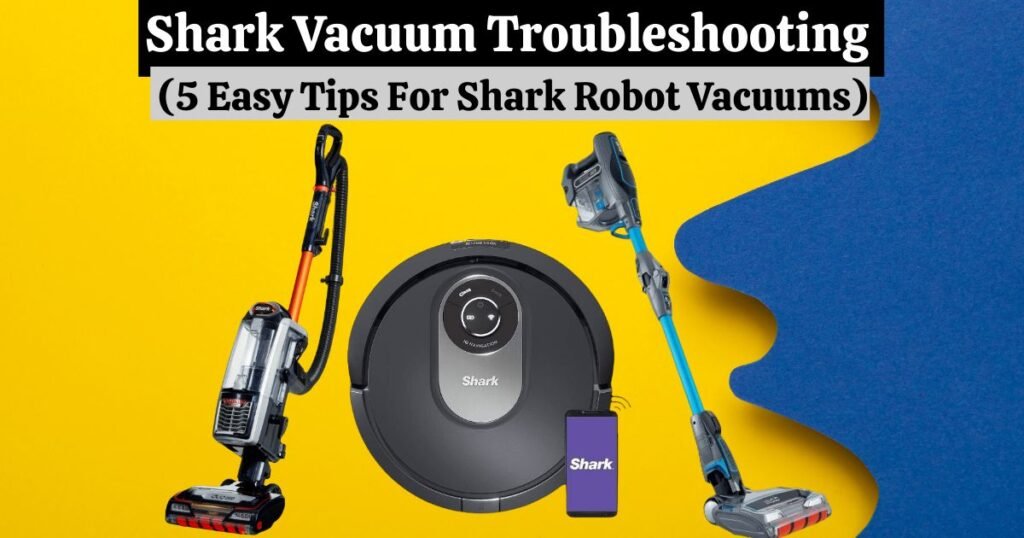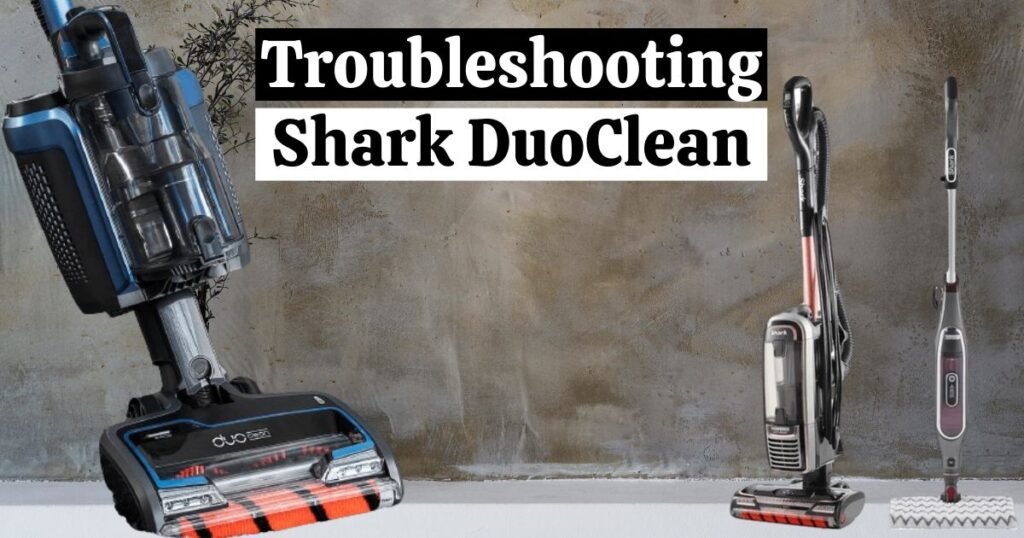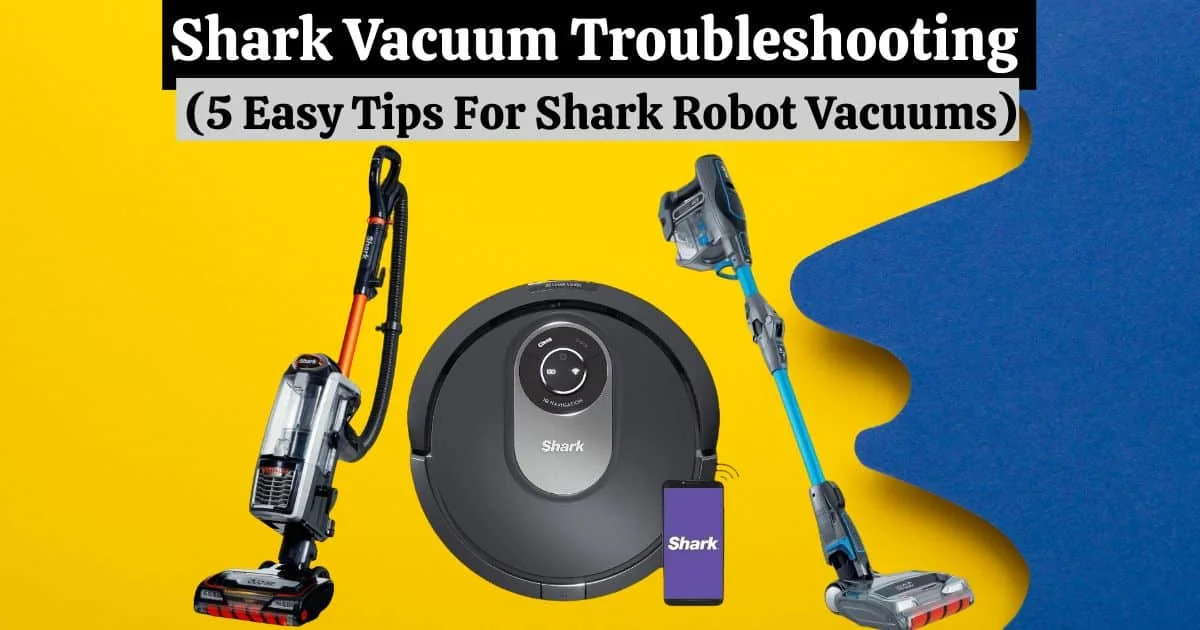
The Shark vacuum troubleshooting guide focuses on the common problems Shark vacuum users face. Shark is one of the best vacuum brands, but is not invincible. Shark vacuums malfunction occasionally.
The most common problems with Shark vacuums include loss of suction, roller brush malfunction, damaged components, overheating, vacuum not turning on, etc. There are possible fixes for all these problems.
Are you having trouble with a Shark vacuum not working? This article can help.
If your Shark vacuum isn’t turning on or isn’t cleaning properly, there’s a problem. Here are some tips for Shark vacuum troubleshooting.
Shark Robot Vaccum Troubleshooting Tips:

You can clean your floors and carpets autonomously with Shark robot vacuums. They may malfunction occasionally. Some common Shark ION RV700, RV800, RV1000, RV2000, and Shark IQ Series problems and Shark Robot vacuum troubleshooting tips are listed below.
1. Shark Vacuum Not Charging:
Sometimes, you may find that your Shark Robot vacuum is not charging. Below are some possible causes and fixes.
- Ensure the side Power button is ON.
- Ensure the charging dock is connected to the power source and ON.
- Check whether the dock’s power cord is working.
- Clean the charging contacts.
The battery is likely dead if your Shark Robot vacuum is still not charging. The solution may be to replace it. A faulty robot vacuum or charging dock could also be a problem.
2. Shark Robot Vacuum Won’t Turn On:
If your Shark Robot vacuum is not turning on, it could be a faulty battery, low battery, or a faulty robot vacuum. Here are possible causes and Shark Robot vacuum troubleshooting Tips.
- Ensure the battery is plugged in, secured, and charged.
- Clean the battery connectors to ensure no obstructions.
You may have a hardware problem, so contact Shark if none of these methods work.
3. The robot does not collect debris:
Your Shark ION vacuum should have no problem picking up household dirt, cereals, pet hair, sugar, kitty litter, and pet hair. You can fix it if it’s not picking up dirt.
(i) Dirty Filters:
Dirty filters or a full bin can also cause your Shark ION vacuum not to pick up dirt. Follow these steps to fix the problem.
- Remove and empty the bin.
- Clean or replace the filter by removing it.
(ii) Jammed or dirty brushes:
The robot’s side and main brushes should be clean to agitate and lift dirt. In this situation, you may see the MAX/”i” flashing together. Follow the steps below to resolve the issue.
- Clean the bristles of the side sweeping brush or replace it if it’s showing signs of wear. Of wear. (Error LED – MAX/” i” flash together)
- If the main brush is older than eight months, remove it, clean the bristles, or replace it. (Error Led – DOCK/MAX/” i” flash together)
- It is also possible that the bin is not inserted correctly. To resolve this problem, insert the bin correctly. (Error LED – Clean RED/MAX flash together)
(iii) Loss of Suction:
There could be a faulty motor causing the Shark Robot vacuum not to pick up dirt when its brushes are clean. This error will be manifested by a pure RED + “I” LED flashing together error. To troubleshoot, follow these steps.
- Inspect the robot and check whether suction exists.
- Check whether the brush roll spins.
Consider buying a new motor if there is no suction.
4. Shark Robot Vacuum Not Connected to WiFi:
Your Shark Robot vacuum may also be unable to connect to WiFi. Check out this Shark Robot Vacuum troubleshooting guide to discover why your Shark ION isn’t connecting to WiFi.
- You entered the wrong password. Ensure that the password is correct.
- There is a long distance between your robot vacuum and the router. If the problem persists, make sure you are within the WiFi range.
- The robot vacuum could be reset, and the app restarted to fix the bug.
- The Shark Server may be down during the weekend.
Abnormal or sporadic movement:
You may find that your robot vacuum moves irregularly. Below are some causes and possible Shark Vacuum troubleshooting.
- A dirty robot’s sensors will compromise its navigation system, causing erratic movements. Clean the sensors under the robot and bumper with a dry cloth.
- Check the wheels for obstructions (Error LED – Clean RED/MAX/” i” flash together).
- If the wheels are worn out, replace them.
- Drive motors might need to be replaced if they are worn out.
- A robot must be moved to another place if there is an obstacle (Error LED – Clean RED or MAX LED flashes).
Shark Vacuum Troubleshooting Guide for Upright, Canister, and Handheld Vacuums

Our second segment examines common problems with Shark upright, canister, and cordless vacuums. Below is a guide to troubleshooting Shark vacuums.
1. Shark vacuum stopped working:
There are times when your Shark vacuum stops working. There are several possible causes. Below are the common reasons Shark vacuums stop working, plus Shark Vacuum troubleshooting.
- Check the socket. During vacuuming, it might not be connected well, or it might have fallen off the socket.
- You may need to replace the fuse if the fuse has blown.
- The thermostat might have turned off because of overheating. Try turning it on after an hour or so.
- You may need to reset the circuit breaker if it goes off, cutting power.
- Though unlikely, your vacuum might be dead. Send it for repairs or replace it.
2. Shark Vacuum Won’t Turn On:
You can fix a minor problem yourself if your Shark vacuum doesn’t power on. Check out these possible causes and fixes for a Shark vacuum that won’t start.
- Your vacuum won’t run if the power cord is not plugged in or if you don’t have mains power. Check that the cable is plugged in and the socket is on.
- Try charging the battery of your handheld/cordless vacuum and trying to power it on if the battery is not charged.
- A burned fuse can also cause this problem, so check it out and replace it if necessary.
- A circuit breaker could have been tripped, so the vacuum needs to be reset.
- If your vacuum is dead, you may have to send it for repairs or buy a new one.
3. Shark Vacuum Loss of suction:
A vacuum that doesn’t suction anything and leaves dirt and debris behind is one of the worst things that can happen. Shark vacuum suction issues like lost suction can be minor or significant problems. The following are some causes and fixes for low suction.
- If your Shark vacuum has adjustable suction levels, you might be on a low level, so adjust it.
- A full dust cup means there is no room for dirt to be sucked in. Emptying the dust cup is the solution.
- Make sure the filters are not clogged, as clogged filters may restrict airflow and cause suction loss.
- A blockage in the vacuum could also cause no suction in the Shark vacuum. Remove the dust cup, intake opening, and hoses to ensure no debris blocks suction.
- Loose hose connections or broken hoses can also cause suction leaks and low suction. Make sure they are installed correctly and in good working condition.
- The motor is faulty if none of the above tips work for you. In this case, you will need to replace the motor or purchase a new vacuum.
You will face the following problems with Shark vacuums, plus their fixes. Below, we have also explored issues specific to some Shark models.
4. Shark vacuum overheating:
Overheating is a common problem with Shark vacuums. You can overheat for several reasons.
- The first culprit, though rarely, is electrical or motor faults. Replace frayed cables if necessary.
- There may also be a clogged filter restricting airflow. Make sure the vacuum is sucking dirt well by unclogging the filters.
- Also, check the dust cup for tiny dirt particles blocking airflow. The problem should be resolved by unclogging the dust cup.
- A jammed brush roll can also cause overheating. Ensure that no dirt or hair tangles are blocking it.
5. Unusual noise coming from Shark vacuums:
When your Shark vacuum is loud or produces inconsistent noise, it is a sign it is overwhelmed. Below are some causes and possible ways to fix them.
- The first culprit is a dirty filter that needs to be cleaned to allow unrestricted airflow.
- A dirty, jammed, or dirty brush roll could also be the reason your vacuum is loud, so clean it.
- A malfunctioning motor could also be the cause. Please wait for the vacuum to cool down and check whether it still makes funny noises.
DuoClean Shark Vacuum Troubleshooting Tips:

Below are some common problems Shark DuoClean users encounter and possible fixes.
1. Vacuum vibrates:
If you notice unusual vibrations in your vacuum, there is a problem. The probable cause and fix are listed below.
- The bristle brush has not been installed correctly, so fasten it.
- The wheels may also be loose, so tighten them.
2. Brushroll Not Spinning:
Sometimes, the red brush roll indicator light on the nozzle will illuminate. When you inspect the cleaning head, you realize the brush roll is not spinning, but the vacuum is running. The following are some of the causes and solutions.
- If the vacuum is on the wrong setting, adjust the power switch to settings I or II.
- If you notice a blockage on the brush roll or soft roller brush, clean them and remove any debris.
- A loosely attached nozzle can also cause the brush roll not to spin.
3. The headlights won’t turn on:
Shark DuoClean comes with headlights that illuminate when the vacuum is in use. Below are some possible causes and solutions if they are not turning on.
- The headlights have come into contact with water, so let the vacuum dry for a few days and see if they turn on.
- You may also need to push the headlights back and see if the problem is resolved.
- Replace the LEDs if neither of the two fixes above works.
Professional Shark Rotator Vacuum Troubleshooting Guide:

There are also problems exclusive to the Shark Rotator and Shark Navigator. Below are some common issues and fixes.
1. Non-spinning roller brush:
You may find that your roller brush is not spinning. Below are probable causes and fixes.
- The first culprit could be that the roller brush switch is off. Turn it on for spinning.
- The brush may also contain debris. Clean it satisfactorily after removing it.
- The brush may not spin due to a disengaged nozzle. Make sure you attach it correctly.
- Last but not least, you may have a broken belt. The problem should be resolved by replacing it. Once the belt is purchased, you can use the Shark Navigator vacuum manual or Shark Rotator manual to fix it.
2. Vacuum tips over:
Shark Rotator and Shark Navigator vacuums are also prone to tipping over. Below are some causes and solutions for vacuums that won’t stand on their own.
Broken latches are a common cause. Check it for damage and replace it.
Your vacuum may also be unable to stand on its own because of an uneven surface. Place it on a flat surface in this case.
Final thoughts:
In conclusion, Shark vacuum troubleshooting does not require a lot of expertise. This complete guide prepares you to resolve common issues, perform routine maintenance, and ensure your Shark vacuum runs smoothly. Take care of minor problems without letting them hamper your cleaning experience.
Now you know how to do Shark vacuum troubleshooting. We hope this guide helped you resolve most of the issues you’re having with Shark vacuums.

